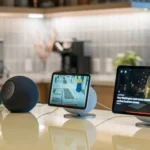
First revealed at the Amazon Event earlier in September, the Amazon Echo and Echo Dot speakers will now turn your warm places into smart spaces with their ability to detect motion and occupancy in your homes. The newer Echo and Echo Dot speakers through the use of “inaudible ultrasound waves” can detect if there are people’s presence in a room and also turn on and off connected devices such as your lights or Fire TV.
Users will have the ability to enable or disable this feature using the Alexa app. Another fantastic capability with this new feature is that users can set up occupancy schedules to turn on lights when they enter a room and then off again when no one is present. Also, Alexa can start playing music or a radio station as soon as motion is detected close to an Echo device during a set time and then shut down the tunes once motion changes. All functions have been listed under Motion Detection in the Alexa app settings for various compatible Echo devices, and there these functions can be toggled on or off.
The motion-sensing features of the newer Echo Show devices are quite similar, only that those rely on their cameras to detect the presence of people in a space. The Echo speakers don’t have cameras, the device only relies on emitting an inaudible ultrasound wave that reflects off nearby objects before traveling back to the device’s microphones to detect motion.

Another tech giant that has succeeded in the use of ultrasound capabilities for its smart devices is Google. The Nest Smart displays and Nest Mini speakers have the ability to detect when a person is close to the display or speaker while offering different interfaces. On the Smart Mini speakers, volume controls appear; however, the difference from the newer Amazon Echo and Echo Dot speakers is that they currently don’t offer the ability to use ultrasound sensing to trigger Google Home Routines.
A number of stand-alone motion sensors have been introduced to be compatible with Alexa, all with the ability to trigger Routines — including those manufactured by Philips Hue, Aqara, and Centralite. In theory, this means that soon users won’t have the need to rely on extra gadgets to turn on lights or music. It also supports Amazon’s vision of an ideal smart home, where your home responds automatically to its occupants with limited prompts. However, for Amazon to get to this point, there will be a need for more effort into the Alexa app and its abilities. Setting up various Routines like turning your lights on at the correct brightness based on time of day then off again when the room is empty would require a lot of patience and a fair amount of technical know-how.
Discover more from TechBooky
Subscribe to get the latest posts sent to your email.



/cdn.vox-cdn.com/uploads/chorus_asset/file/24296640/KOHLER_Numi_2.0_aad24400_rgb.jpg)



